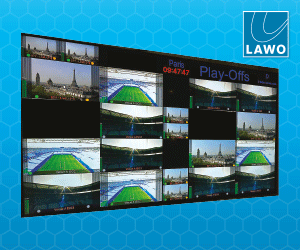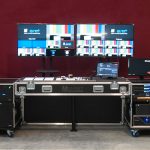Although the idea of 4K imaging is not new, its adoption has been posing a challenge for broadcasters. With more momentum being built around the technology, we explore some of the basics for migration to higher resolutions This may come as a shock to some broadcasters, but the idea of 4K imaging is not new. […]
Although the idea of 4K imaging is not new, its adoption has been posing a challenge for broadcasters. With more momentum being built around the technology, we explore some of the basics for migration to higher resolutions
This may come as a shock to some broadcasters, but the idea of 4K imaging is not new. In the movie world, 4K has been around for 20 years, from the very first days of digital intermediate post production. The theory is that 4K 4096 pixels per line is a pretty good match for the absolute resolution of 35mm film.
Today, though, a new sort of 4K has come to the fore, designed for video. This is a slightly different definition of 4K: 3840 x 2160 pixels, or four times the resolution of todays HD. The consumer electronics people have dubbed it as Ultra HD for this reason.
If it has four times the pixels then it must be four times as good, right? Well, as much as I hate to say this, but hidden in the hype, there are some significant limitations in the 4K we are talking about today. Not least of these is any suggestion that we might standardise on a different frame rate.
By limitations, I mean short-term technical issues. When we view programmes on television, our minds have been trained for certain expectations. Part of this is due to how creative and technical directors portray how we visually perceive a programme.
So why do we care about this technicality when we simply want to have 4K running in our facility? This is a key part of the misconception. Most of the 4K we see today is running at film frame rates. Tests have shown that when we are viewing live television at film rates a slow 25 frames a second our minds think we are watching a movie. At its most extreme, live news can be perceived as a fictional movie, which I think we would all agree would not be a good thing.
The reason that the currently proposed 4K technology sticks with low frame rates is simple: to use less data. Even HD at 24, 25 or 29/30 FPS stretches the ratio of static to motion detail. These frame rates are well below those needed to deliver the kind of visual experience 4K is capable of, and when watching 4K at lower frame rates, it detracts from the full 4K experience. It is perfectly simple: great-looking spatial detail requires a comparable temporal resolution. For 4K television to be stunning, it needs to be running at 50p or 60p.
Going through these details sets the scene about good-looking 4K television and helps us to understand the wiring needed within the broadcast facility. Without getting too deep into some of the nuisances that make 4K different to HD, just consider 4K as four times more data, and also remember that 4K is inherently a progressive scan.
This leads us to have a clearer understanding of what is required. We know that 3Gb/s is needed for 1080p50/60, so four 3Gb/s “pipes” are needed for 4K running at 50p or 60p. Remember what I said about movies and the 4K hype? For this they are typically running 24p, 25p or 30p, which only requires half the bandwidth hence, only two 3Gb/s pipes.
While many 4K cameras record directly to memory, some offer live outputs via four 3Gb/s SDI connectors. This is the format needed to support 4K within a broadcast plant. Now if your plant only supports 1.5Gb/s, you would need eight co-axes, which does get messy. Four lines is bad enough, but thinking back to the days of analogue, production houses that kept away from composite video ran RGB and sync, over four co-axes, which was not impossible to handle.
Labelling is crucial: this includes both physical labels on wiring and patch-panels, and soft labelling in databases. In a single co-ax per signal world, finding the right signal in a large plant can be difficult enough, but think of trying to find four linked signals! Documentation is crucial.
We would classically think of having supporting 4K support by building “4K islands”, just as we had “digital islands” during the transition from analogue. If your plant already supports 3Gb/s routing, you are in good shape. Extra paths will be needed to handle 4K, but this should not be an issue as most mid to large size routers are expandable to handle growth.
Although router control systems can switch four signals together as salvos, or simply with four different takes, having one that can support 4K certainly makes life easier.
To future-proof broadcast plants, 3Gb/s directly does the trick and many infrastructure products are already 3Gb/s-ready. Some simply need software upgrades and have device control parameters set for various uses. In Figure 1, we can see a router drop-down menu for connection ports. For 4K considerations, different options are available for binding together two (dual) or four (quad) ports for different 4K frame rate options. For longer runs, Harris Broadcast has a cool card that puts four 3Gb/s onto a single fibre, which provides the assurance that the 4K signals are travelling together.
A few final words about routing and distribution. In the days of RGB, timing was very critical. However in todays digitally buffered world we do not have the same issues, so basic routing and distribution delays are of no concern. A word of caution though: since frame syncs are all over the plant, and often put in for one feed and later forgotten, be sure paths are matched at least within half a line. More is OK, but if these are sloppy they will predictably come back later to bite you!
Beyond routing and distribution is where the kicker comes into play, when we look at servers and storage. Putting four 3Gb/s SDIs into a server is not difficult. However ensuring they can record, compress and play back simultaneously is a concern. Additionally 4K signals will be wrapped directly into the server as a single file, not as four streams. Can the server support this? What compression format will be used?
Assuming your server plays out the four streams reliably, joining four switchers or even having multiple logo and branding products linked together can get you on-air with 4K. This issue will be the final distribution scheme as 4K has a lot of bits to get to the home user! New compression formats like HEVC will be required and most likely HEVC decoders will be built directly into television sets within the next couple of years.
So after reading this, you may have decided that 4K is not worth a look within your broadcast plant. I disagree.
In the production environment, 4K is going to be great! Shooting at 4K and using file-based editing systems is perfect. Zooms and pans for HD can be produced in post more elegantly without a loss in resolution, resulting in lower HD production costs and fewer re-shoots. The statement “fix it in post” will have new meaning. In this environment, 4K streams never happen beyond the editing room, with the final output as HD files.
4K is also very useful in master control and monitoring environments. The switch from having a wall of multiple CRTs to flat screens has created a dilemma: users forget that putting 16 virtual screens on a single HD monitor whatever the size is clearly not the same as having 16 HD monitors. The maximum resolution of the monitor is divided by 16 for each individual display.
As operators often sit very close to the monitors, switching to 4K displays radically improves quality. Figure 2 shows a typical MCR layout. Notice the programme feed is one quarter of the flat screen. When using both a 4K multiviewer and monitor this means the operator is viewing actual HD resolution, since 4K is four times HD resolution.
If you ever get the chance to compare frame rates at the same spatial resolution, you will realise that more pictures per second make a very much greater difference to perceived detail than simply throwing more pixels at the screen. So we should be pushing hard for 1080p at 50 or 60 for all production, even if we have to down convert to 1080i or 720p for broadcast.
If we are going to implement 4K in the short term as an acquisition and post format, we need to be looking at these frame rates at the very least. It would be nice to hope that we have high frame rate 4K on the roadmap when it finally becomes a consumer product.
For now, though, if you are already on a 3Gb/s strategy then you are in a good position to embrace both 1080p and 4K signals. You can look ahead to an even brighter future.
Stan Moote is VP Business Development at Harris Broadcast.















































































